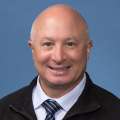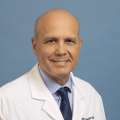Ariyana Hernandez’s obstetrics appointment on a Friday in late January was supposed to be a routine 28-week checkup. But during the ultrasound, her obstetrician noted what appeared to be a mass on the baby’s heart.
The hours that followed were a blur: an appointment with a specialist, then an immediate referral to UCLA Health for a pediatric cardiology evaluation. By the end of the day, Hernandez had met with , co-director of UCLA’s fetal cardiology program, who identified the mass as a rare pericardial teratoma, and she had talked by phone to high-risk obstetrician/gynecologist , who arranged to see her Monday morning.
Rush to organize a team of specialists
A pericardial teratoma, in which a tumor is growing in the pericardial sac surrounding the heart, is quite high risk and very rare, Dr. Satou explained. “People in my field may have seen them zero to a couple of times in their careers.”
In this case, he said, the tumor was several times larger than the heart and was pressing on it. Fluid was accumulating in the sac that surrounds the heart, stressing it further.
Drs. Satou and Afshar immediately started to assemble an interdisciplinary care team that included , chief of congenital cardiovascular surgery.
“An unexpected diagnosis like that can be jarring for any family,” said Dr. Afshar, professor of Obstetrics and Gynecology in the Division of Maternal Fetal Medicine at the David Geffen School of Medicine at UCLA. “This was not their birth plan; this was not the birth story that they expected.”

Delivering a baby that prematurely carries its own risks, Dr. Afshar said. “The trigger point, from an obstetrical and maternal-fetal standpoint, is, ‘When is the baby safer outside than inside?’”
By the time of Hernandez’s appointment with Dr. Afshar, the baby’s condition was getting worse. Even though Hernandez was only approaching 29 weeks’ gestation, the baby’s best hope for survival was a cesarean birth and immediate heart surgery.
Hernandez was admitted to the hospital that day and the operation was scheduled for two days later. In preparation, she was given betamethasone to accelerate the baby’s lung maturity and help guard against respiratory issues premature babies can face.
“The best chance the baby had for survival was to get her out relatively promptly and have massive teams of specialists ready literally at the mom’s abdomen,” Dr. Satou said.
Cesarean birth, then heart surgery
Because of the criticality of the baby’s condition, the birth was scheduled in one of UCLA’s main operating rooms, next door to Dr. Van Arsdell’s pediatric cardiac operating room (rather than in a more common high-risk OB operating room). “We had two operating rooms going at the same time,” Dr. Afshar said.
In one room, she operated on Hernandez, and in the other, Dr. Van Arsdell’s team was scrubbed and ready to jump into action.

The cesarean birth was “coordinated and timed,” said Dr. Afshar. In a situation like Hernandez’s, “my primary role is to make sure the mother is safe. I am mom’s physician. I am her surgeon, and I am with her until she gets out of the operating room.”
Dr. Afshar also concentrated on doing what she could surgically to “optimize the birth,” including delayed cord clamping: waiting until the umbilical cord stopped pulsing before cutting it to allow more placental blood transfusion and increase hemoglobin levels.
“It was scary,” Hernandez recalled, “but they did a really good job of trying to make sure that I felt as comfortable as possible.”
Through a stroke of luck, Hernandez had discovered that a family friend, Michelle Ellis, RN, is a labor and delivery nurse at UCLA Health. Ellis was able to get assigned to be Hernandez’s primary nurse during the delivery and was there to hold her hand when Hernandez got her epidural prior to the operation.
The anesthesiologists also “went above and beyond to make me feel comfortable,” Hernandez said, “knowing how scared I was of needles and surgery.” One of them used his iPhone to play music while she got her epidural, then quickly put together a playlist for her to listen to during the operation. He, along with Hernandez’a husband, Stephan, held her hands during the surgery: “Stephan was on one side, and the anesthesiologist was on the other side,” she said.
Shortly after baby Havanah was born, her heart stopped beating.
“They were doing chest compressions and CPR to keep her alive before surgery,” Hernandez said. But they were extremely discreet. “That was in the same room where I was, but I had absolutely no idea that this was going on.”
Havanah was rushed next door to Dr. Van Arsdell’s operating room, where he opened her chest, hoping that would give her heart enough extra space to be able to beat on its own.
But when he did so, “all you could see was the tumor,” he said. “You had to lift it and pull it to the side to be able to see the heart.”
That meant Havanah had to be connected to a heart-lung machine – an ECMO (extracorporeal membrane oxygenation) machine – that could take over for her heart temporarily.
Using ECMO was extremely risky, given Havanah’s size: about 2 2/3 pounds. “Normally, ECMO is not performed on such a small baby,” Dr. Satou explained.
“It’s a ‘can they tolerate it’ issue,” Dr. Van Arsdell said, given the physiology of a baby of that size, including the potential for brain bleeds. But in Havanah’s case, going on ECMO provided her best hope for survival, enabling the surgical team to remove as much of the tumor as possible. “Then we could see whether the heart could take off on its own,” Dr. Van Arsdell said.
After Havanah was hooked up to the ECMO machine, Dr. Van Arsdell used an ultrasound probe directly on her heart to provide imaging to guide the surgery. He then carefully removed the non-cancerous tumor that was squeezing on the heart and causing fluid to gather in the sac around the heart and further compress it.
“(Dr. Van Arsdell) had to do very fine removal of smaller parts of the tumor where it was near the great arteries that supply the brain and the body and near the coronary arteries that supply the heart,” Dr. Satou explained. “As a team, we were going back and forth deciding just how much to remove or if we’re going to leave a little bit for safety.”
In the end, the team decided to leave a very small portion of the tumor in place. “It’s a little bit tricky to remove it without damaging the heart, Dr. Van Arsdell said. “Bit by bit, we were able to work our way through it and get essentially all the tumor out except for a tiny little bit. And that created space for the heart to work.”
The hope was that Havanah could come off of ECMO as quickly as possible given the potential complications. It wasn’t yet certain whether her heart and lungs were up to the task, so it was a positive sign when she was able to be weaned from the machine before being transported to the neonatal intensive care unit (NICU).
At that point, Havanah had “a heart and blood pressure support medicine, along with very aggressive ventilation,” Dr. Van Arsdell said. And her chest was still open: The team had to wait for the swelling to go down and the need for all of the medications to abate before safely closing the incision.
Havanah’s recovery
It was only after Havanah was taken to the NICU that her parents were allowed to see her again. Stephan slept by her bedside for the first few days. Ariyana was still hospitalized as she recovered from the cesarean birth but was also able to visit Havanah.
With Havanah’s chest still open, “you could see straight through to her heart,” Ariyana said.
Havanah was also on a paralytic to keep her from moving around while the incision was open; as a result, she developed a pressure sore on the back of her head.
After about a week, as Havanah’s condition improved, the surgery team closed up the incision.
Once Ariyana was discharged, she and Stephan, who own a marketing agency and creative studio, quickly established a new routine of spending 15- to 16-hour days in the NICU and conducting business from there.
“We actually ran our business from the NICU,” Ariyana said. “I took conference calls with my AirPods. We wanted Havanah to know that she wasn’t alone, and we wanted her to hear our voice.”
Havanah was 2½ weeks old when she was finally stable enough for her parents to hold her for the first time.
Ariyana and Stephan also learned how to care for her – from bathing her to taking her temperature to swaddling her. Despite Havanah being under the constant care of the neonatal nurses, “not only did they take the time to teach us, they let us do it,” Ariyana said. “It made us feel more like parents, because the whole process of having a baby in the hospital can make you feel disconnected.”
Havanah was discharged in mid-March, two months to the day from her birth.

“I think we were running on adrenaline for the first week,” Stephan said of the family’s return home. “It was exciting and exhilarating and exhausting – and also really scary, not having all of the monitors. But it was also really beautiful. As quiet as they try to make the NICU, there’s still the constant hum of machines and beeping of monitors and nurses talking, doctors talking, alarms sounding. So being home and just being by ourselves, it felt like, ‘Oh, this is real, we’re actually parents. We’re a family.’”
A positive prognosis
Since then, Havanah has continued to thrive. “If you looked at her right now, you would have no idea what she went through, unless you saw her scar,” Ariyana said.
“She’s a little small, but other than that, she doesn’t seem behind in any way,” Stephan added. “Developmentally, she’s doing stuff that I don’t think she’s expected to do for another month or two because of her prematurity. She made it through the fire and is now in regular premature baby territory.”
Havanah continues to have regular appointments with UCLA specialists to assess her progress. Babies who are born at 29 weeks can have a range of issues, including retinopathy of prematurity (ROP), an eye condition that can be partially caused by receiving supplemental oxygen. In Havanah’s case, her eyesight has been correcting itself, Ariyana noted.
The prognosis for her heart is also good, Dr. Satou said. “I suspect she’ll never need another cardiac intervention.”
Havanah’s story “demonstrates the power of being able to deliver a baby where there’s a heart surgery team there as well,” Dr. Van Arsdell said. “We have an experienced team all right there: experienced delivery team, experienced cardiology team, experienced baby heart surgery team. When these babies have to have immediate attention, there’s not time to transport them to another hospital or time to transport them across the street. You just do it all together right there.”
Although Havanah’s birth was very different than what they’d planned, Ariyana feels “very blessed and fortunate” that it happened at UCLA.
It really was “a miracle,” Stephan said. “It’s just a testament to the hospital, the staff, the doctors and the power of prayer. There were so many things that if they didn’t go just the way they did, she wouldn’t be here.”
Lisa L. Lewis is the author of this article.



